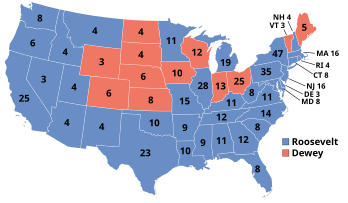| ← 1942 1943 1944 1945 1946 → Presidential election year | |
| Election day | November 7 |
|---|---|
| Incumbent president | Franklin D. Roosevelt (Democratic) |
| Next Congress | 79th |
| Presidential election | |
| Partisan control | Democratic hold |
| Popular vote margin | Democratic +7.5% |
| Electoral vote | |
| Franklin D. Roosevelt (D) | 432 |
| Thomas E. Dewey (R) | 99 |
 | |
| 1944 presidential election results. Red denotes states won by Dewey, blue denotes states won by Roosevelt. Numbers indicate the electoral votes won by each candidate. | |
| Senate elections | |
| Overall control | Democratic hold |
| Seats contested | 35 of 96 seats (32 Class 1 seats + 4 special elections)[1] |
| Net seat change | Republican +1[2] |
 | |
| 1944 Senate results
Democratic gain Democratic hold | |
| House elections | |
| Overall control | Democratic hold |
| Seats contested | All 435 voting members |
| Popular vote margin | Democratic +4.7% |
| Net seat change | Democratic +22 |
 | |
| 1944 House election results
Democratic gain Democratic hold | |
| Gubernatorial elections | |
| Seats contested | 32 |
| Net seat change | Democratic +3 |
 | |
| 1944 gubernatorial election results
Democratic gain Democratic hold | |
The 1944 United States elections was held on November 7, 1944, during the final stages of World War II. President Franklin D. Roosevelt was easily re-elected to an unprecedented fourth term, and the Democratic Party retained their majorities in both chambers of Congress.
During the presidential election, Roosevelt was in office for three terms and eleven years, making him the longest-serving President in U.S. history. As the incumbent president, Roosevelt was renominated by the Democratic Party, while in the Republican primaries, New York Governor Thomas E. Dewey won his party's nomination. In Texas, the Texas Regulars was formed to block Roosevelt's reelection over the New Deal and his perceived supportive policies on African Americans, but their efforts were unsuccessful. Roosevelt defeated Dewey in a landslide, taking 432 electoral votes against Dewey's 99 electoral votes.
In the congressional elections, Democrats maintained control of Congress. In the Senate, Democrats lost seats but maintained control of the chamber. In the House of Representatives, Democrats won the popular vote by a margin of 4.7 percentage points and gained 22 seats for a healthy majority after spending the last term holding a razor-thin majority. In the governorships, Democrats gained three seats.
The elections were a referendum on Roosevelt's execution of the war. With the United States and the Allies delivering successful results against the Axis powers, especially with the fall of fascist Italy a year ago and the Normandy landings the last summer, the public rallied around the Democrats. After the election, Roosevelt died in office in April 1945 after his fourth inauguration.